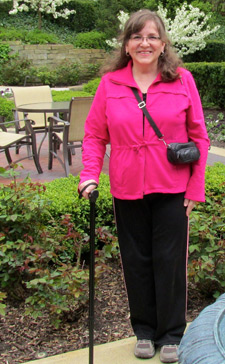 "I’m Tracy, 53, from Ohio and West Virginia. I was diagnosed with Neuroacanthocytosis in 2011 at Ohio State University’s Parkinson’s and Movement Disorders Clinic.
"I’m Tracy, 53, from Ohio and West Virginia. I was diagnosed with Neuroacanthocytosis in 2011 at Ohio State University’s Parkinson’s and Movement Disorders Clinic.
"Although waxing-and-waning orofacial, neck, shoulder, and thumb tics began at the age of 7, I didn’t have any other neurological problems until I was 41. I was still bike riding, ice skating, and swimming at 40. I enjoyed these activities as well as many others since childhood. Now I have difficulty just washing my hair.
"Although I had some pain in my shoulder and neck, I had good coordination, balance, strength, endurance, concentration, cognition, multi-tasking skills, and eating and swallowing abilities without meds. But when that pain became worse at the age of 25, I consulted a movement disorders neurologist at Ohio State University. I was misdiagnosed with Tourette's but took some medication and was continuing to work but did have regular checkups.
"My neurological symptoms started with tripping, dropping things, buzzing in my thigh, burning in my chest and throat, and twisting of my waist. After many tests and a referral to Cleveland Clinic, they ruled out numerous conditions such as Wilson's Disease.
"Over time, as symptoms were evolving and worsening, Stiff Persons syndrome, Parkinson's disease, Friedreich’s ataxia, Huntington's disease (genetic testing), Parkinson's Plus diseases, ALS, and others were ruled out at Ohio State University. I was tested for NA in 2011, when acanthocytes were revealed. I do have relatives on both sides of the family with concerning symptoms.
"I’m thankful there are treatments that help me with this devastating disease. I’m still on the anti-seizure med and I agreed to Botox. For me, the benefits outweigh the risks. When I could no longer walk in 2010, I was prescribed one Parkinson med per day and started walking again. I now take four of those pills a day and still struggle to walk at times. My cane is awesome, though. The tapping makes a brain-body connection that helps me walk. My cane also helps keep my body straight and balanced. It took me years to use a cane fulltime, but I learned through my former physical therapist at Ohio State University not to think what others may think.
"It's been a journey of broken dreams: dissolving my 15-year marriage; making PhD candidacy but not completing my dissertation; becoming disabled; leaving a career I really enjoyed; giving up driving; trying to make sense of dementia; and depending on others. On the other hand, it's been a journey of blessings: realizing what's truly important in life; making new, supportive friends; learning how to adapt (and re-adapt and re-adapt) to my NA challenges; gaining knowledge of neurodegenerative diseases; and relating and empathizing with others with such rare neurological disorders.
"Five years ago I moved from Columbus, OH, back to Eastern Ohio. I have an apartment in a nice, walkable area of Wheeling, West Virginia; my mom and dad live eight miles away on the Ohio side. My mom helps me much, especially driving me to the University of Pittsburgh Medical Center. Through my faith, relaxation, walking, traveling, hobbies, and supportive friends and family, I’m able to cope.
"My goals for 2017 and 2018 are doing a Western Blot; joining the NA Registry; being in touch with NAers; donating blood and tissue samples to the University of Michigan’s research; fundraising for NA Advocacy and the University of Michigan’s neuro-degeneration initiative; and spreading the word about Neuroacanthocytosis. I thank all researchers working on better treatments and an NA cure! It’d be super if lives could keep pedaling and gliding along in a swimmingly way."
Here at the Advocacy we want to thank Tracy for her story and for her thoughts about the journey, about all the people she has met along the way, and about her ambitious and welcome objectives for the next years. We loved your smile and enthusiasm in Ann Arbor!